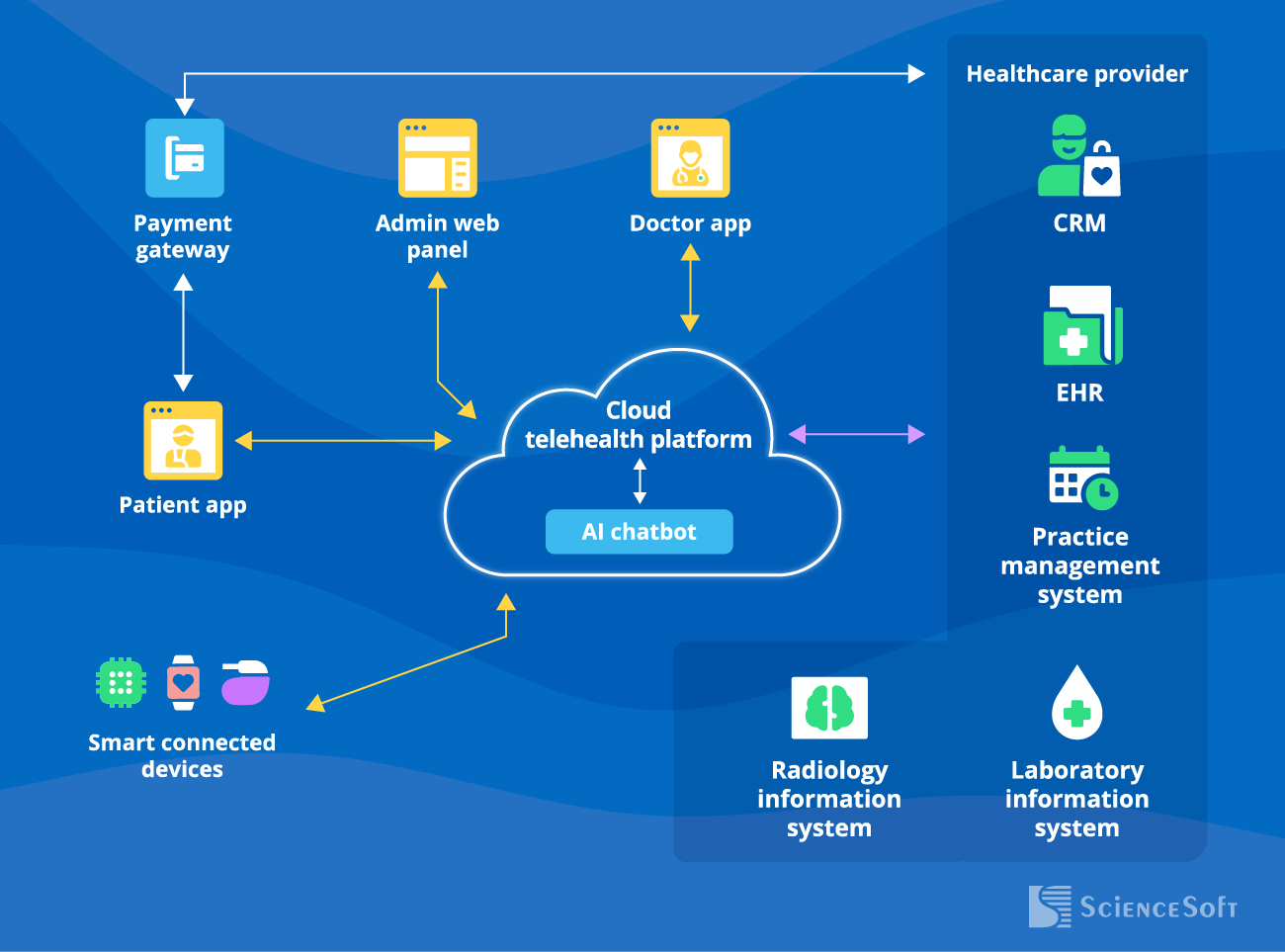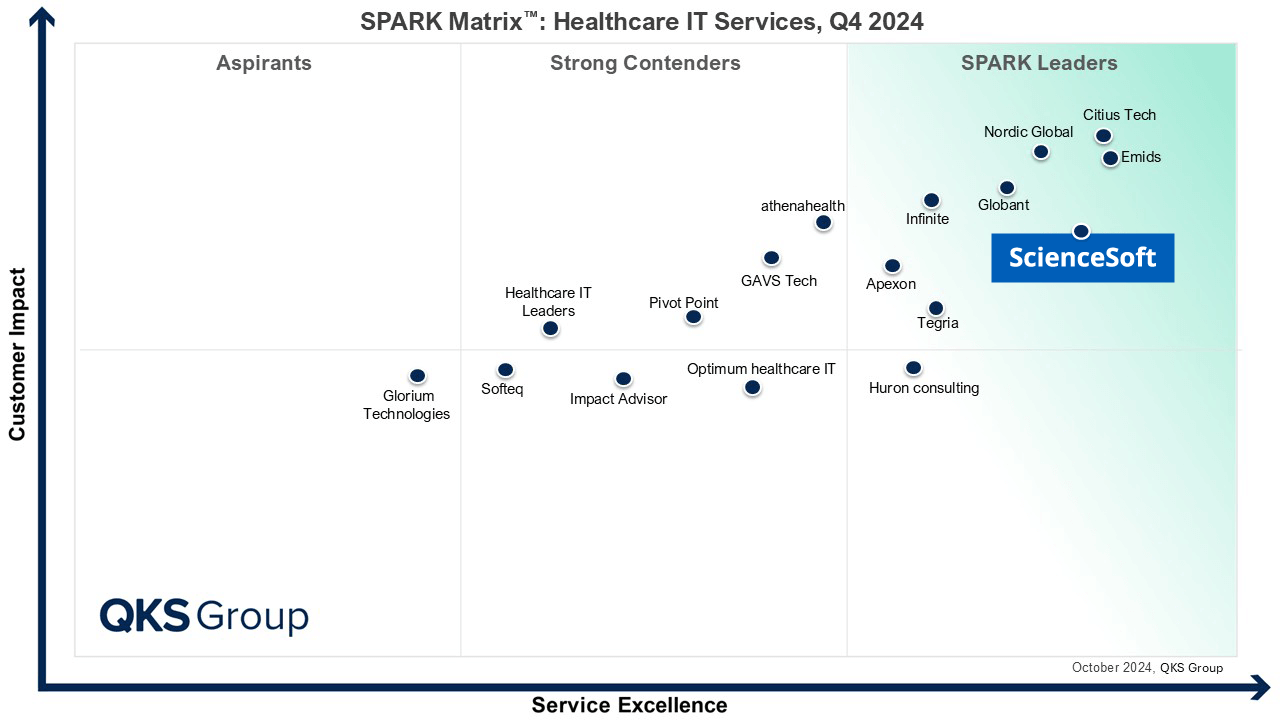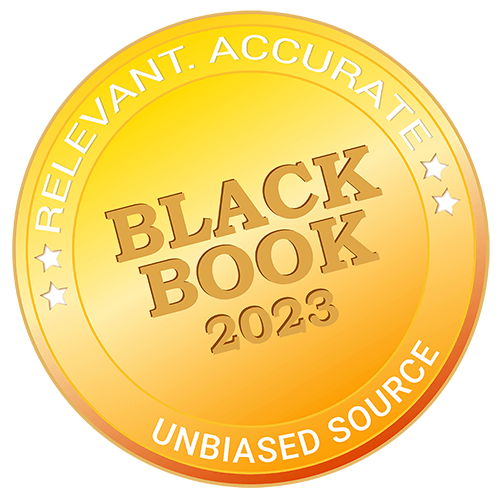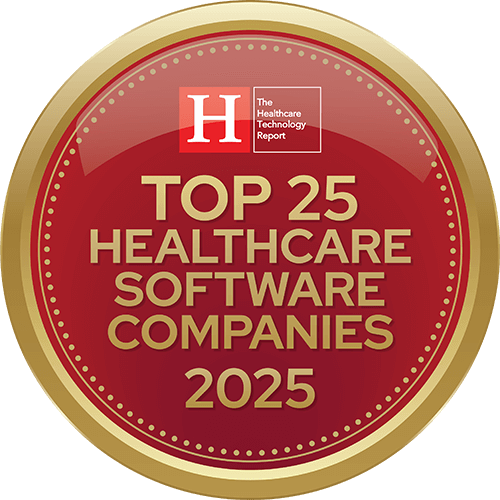Doctor-On-Demand App Development
Features, Architecture, Skills, and Costs
ScienceSoft draws on 20 years of experience in healthcare IT to help both healthcare software product companies, including startups, and healthcare providers create reliable and user-friendly doctor-on-demand apps.
Doctor-On-Demand App Development in a Nutshell
Doctor-on-demand app development enables healthcare providers to give patients immediate access to online consultations with qualified specialists in urgent, primary, preventative, and chronic care. Along with telemedicine functionality, such apps may provide e-prescribing, medication mailing, treatment management, and in-app billing capabilities.
Roles in a doctor-on-demand app development project: project manager, healthcare IT consultant, software architect, DevOps engineer, UX and UI designers, software developers (front-end, back-end, mobile), QA engineers, cybersecurity and compliance specialists.
Cost: $150,000–$250,000+, depending on the app's complexity. Use our free calculator to learn the cost for your case.
Doctor-On-Demand App Market
The global doctor-on-demand software market is growing rapidly and is expected to reach $504.24 billion by 2030, with a CAGR of 19.7%. Doctor-on-demand apps enhance care convenience and accessibility, leading to improved patient outcomes and a reduction in paperwork, hospital readmissions, and service costs.
Key Features of Doctor-On-Demand Software
Doctor-on-demand apps enable patients’ immediate access to online consultations with healthcare specialists. Along with telemedicine functionality, such apps often feature e-prescribing, medication mailing, treatment management, and in-app billing.
Doctors offering their services through an on-demand app must verify that they have a license and are qualified to practice medicine in their respective states. Ideally, your app should allow patients to check their physician's credentials — this ensures service transparency.
Sample Architecture of a Doctor-On-Demand Application

Key Development Steps for Doctor-On-Demand Software
Doctor-on-demand app development is a project requiring a special attention to compliance requirements, performance, and user convenience. Below, our team shares a sample outline of steps we follow in such projects.
1.
Discovery and planning
- Analyzing the target audience (demographics, preferences, pain points) and the competitors' offerings, defining a value proposition.
- Identifying the applicable regulations to comply with, e.g., HIPAA and NCPDP (for the US), GDPR, MDR, IVDR (for the EU), HAAD and DHA standards (for the UAE).
- Eliciting functional and non-functional requirements for the solution and creating a software requirements specification.
- Determining the project scope, timeline, and team.
- Defining KPIs for project progress assessment.
- Creating a business case and calculating the development cost and ROI.
- Designing a risk mitigation plan.
In doctor-on-demand app development projects that involve ePHI handling or software integration with health information exchanging systems, we consistently sign a Business Associate Agreement (BAA). This protects our clients from PHI disclosure and potential misuse, ensuring HIPAA compliance.
2.
Architecture, UX, and UI Design
- Outlining the solution's architecture, tech stack, and necessary integrations (e.g., EHR/EMR, wearables).
- Creating user personas and mapping user journeys for doctors and patients.
- Building UX wireframes.
- Performing UX testing.
- Designing an attractive and accessible user interface.
3.
Coding and QA
- Setting up environments for development and delivery automation (e.g., container orchestration, CI/CD).
- Building the app's front end and back end.
- Integrating the app with the required systems, including wearables and medical devices.
- Evaluating the solution's performance and responsiveness in different usage scenarios.
- Ensuring the app's accessibility.
- Conducting quality assurance throughout the development, including security testing.
4.
Pre-launch activities and release
- Updating and finalizing software documentation for smooth compliance certification (e.g., in accordance with ISO 13485, CFR 11, and IEC 82304-1:2016 standards and regulations).
- (Optional) Assisting with FDA/CE submission and the regulatory clearance process.
- (Optional) Carrying out beta testing (launching the app to a limited group of real users) and adjusting the app based on user feedback.
- Launching the application.
If your app features e-prescribing, it is imperative to certify it according to the FDA's 21 CFR 11 standard because every e-prescription requires an electronic signature of a qualified medical professional.
5.
Support, maintenance, and evolution
- Introducing new physician- and patient-facing features, customization capabilities, and integrations.
- Improving the solution's non-functional capabilities, such as performance or interoperability.
- Conducting regulatory compliance checks and performing timely bug fixing.
Consider Professional Services for Your Doctor-On-Demand App
Why Choose ScienceSoft for Doctor-On-Demand App Development
- Since 2005 in healthcare IT, a deep understanding of healthcare specifics.
- Since 1989 in software development, since 2003 in cybersecurity.
- 750+ IT specialists skilled in application design, development, and QA.
- A quick project start (1–2 weeks) and frequent releases (every 2–3 weeks).
- Over 150 successful healthcare IT projects.
- Mature Lean, Agile, and DevOps practices.
- ISO 9001, ISO 27001, and ISO 13485 certificates proving our dedication to quality, data security, and medical software regulatory compliance.
Our awards and partnerships

Featured among Healthcare IT Services Leaders in the 2022 and 2024 SPARK Matrix
Recognized for Healthcare Technology Leadership by Frost & Sullivan in 2023 and 2025
Named among America’s Fastest-Growing Companies by Financial Times, 4 years in a row

Top Healthcare IT Developer and Advisor by Black Book™ survey 2023
Recognized by Health Tech Newspaper awards for the third time (2022, 2023, 2025)

Named to The Healthcare Technology Report’s Top 25 Healthcare Software Companies of 2025
ISO 13485-certified quality management system
ISO 27001-certified security management system
Common Roles in ScienceSoft's Doctor-On-Demand App Development Projects
Project manager
Plans and coordinates app development; communicates the progress to stakeholders; manages the risks related to development timelines and software quality; ensures timely app delivery.
Healthcare IT consultant
Researches the market and competitors; translates the customer’s needs and the target audience’s expectations into requirements; documents the features and integrations with other systems.
Software architect
Designs the optimal solution architecture, including integration points with the required systems (e.g., EHR, LIS, wearables); chooses the best-suited software tech stack.
UX designer
Analyzes user needs; creates user personas and scenarios; develops UI wireframes and prototypes; conducts usability and accessibility testing.
UI designer
Creates role-specific user interfaces tailored to the needs of patients, physicians, nurses, and administrative staff; refines the visual design based on user feedback.
DevOps engineer
Containerizes and automates software development workflows to support fast and secure app delivery and deployment; monitors app performance and availability.
Front-end developer
Delivers sleek and intuitive GUI elements in accord with accessibility guidelines; fixes code issues detected by the QA engineer.
Back-end developer
Builds a cloud telehealth platform; fixes the code to address the errors found by the QA engineer.
Mobile developer
Creates iOS or Android app versions.
QA engineer
Designs and implements a test strategy, a test plan, and test cases to conduct functional and non-functional testing; reports software defects and verifies their fixes.
Regulatory consultant
Gives recommendations on software architecture components, tech stack, and development process; ensures the app's regulatory compliance (e.g., with HIPAA and GDPR).
Cybersecurity specialist
Assesses cybersecurity risks; detects vulnerabilities in the architecture and code of the cloud platform, patient and doctor apps; ensures the software fulfills all security requirements; implements access control mechanisms.
Sourcing Models for Doctor-On-Demand App Development
Technologies We Rely On
Low-code development
QA tools
DevOps
Containerization
Automation
CI/CD tools
Monitoring
Telehealth
Video streaming
Messaging and conferencing
Costs of Doctor-On-Demand App Development
Depending on the project’s scope, doctor-on-demand app development usually costs between $150,000 and $250,000+ (regular license fees for cloud services excluded).
$150,000–$200,000
A basic solution integrated with one EHR system and featuring virtual appointments, secure messaging, file sharing, and patient data storage.
$200,000–$250,000
A more complex app integrated with one or several EHR systems, featuring real-time consultations, detailed patient and doctor profiles, e-prescriptions.
From $250,000
An advanced app integrated with all the required systems, featuring telehealth capabilities, medication management, and AI-powered analytics and reporting.
Want to Know the Cost of Your Solution?
Our consultants are ready to provide tailored estimates for your doctor-on-demand app initiative.
About ScienceSoft
A US-headquartered IT consulting and software development company, ScienceSoft has been building robust web and mobile applications for the healthcare industry since 2005. Our ISO 13485, ISO 9001, and ISO 27001 certifications show our dedication to the quality of the solutions we deliver and guarantee the full security of our clients' data. Our top priority is driving project success no matter what while keeping to the agreed time and budget and responding to uncertainties agilely.












